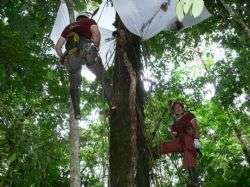Whale communication could explain how extreme ultrasonic bushcrickets transfer sound

Ultrasonic bushcrickets could be using a similar method to communicate as that used by whales, according to newly published research.
Dr Fernando Montealegre-Zapata, and his student Fabio Sarria-S from the School of Life Sciences, University of Lincoln, UK, studied the katydids or bushcrickets ultrasonic call frequencies at Gorgona National Natural Park - an extremely humid rainforest located on a Colombian island in the Pacific Ocean.
Katydid species that have extreme ultrasonic frequencies face a problem: ultrasounds travelling in air suffer excess attenuation (weakening) because the wavelength is too short, therefore objects in the dispersive path, such as leaves and branches, interfere and degrade the signal. Sound attenuation is also imposed by environmental conditions such as temperature and humidity. Therefore Dr Montealegre-Z set out to test the hypothesis that the katydids should prefer microhabitats that favour efficient signal transmission.
The team studied 25 species of katydids, which used a variety of song frequencies, ranging between 9 and 150 kHz. It was observed that species with extreme frequencies (>120 kHz) prefer habitats above 12 metres but below the canopy where the vegetation is not cluttered. Ultrasonus (© F. Sarria-S & F. Montealegre-Z), a new genus incorporating three new species with the most extreme ultrasonic signals ever recorded in arthropods, is an example.
Dr Montealegre-Z said: "We think these insects use some kind of environmental channel to broadcast their calls at long distances. For instance, previous research suggests that whales can send a signal from one continent to another because they use the special conditions of the ocean. The ocean offers an amazing 'channelling' property that is a function of depth and temperature (sound travels faster at the top and bottom of the ocean, slower in the middle), and salinity. Refraction of waves then causes sound to be trapped in a region of low velocity sound transmission. So, whales can send a signal channelled within this region from one continent to the other in a few hours.
"We think a comparable system occurs in the rainforest, where the call of extreme ultrasonic katydids has a similar effect of being able to travel longer distances through the air at that particular height. Of course the ocean and the air are environments with enormous differences for sound propagation. In the ocean sound travels five times the speed it reaches in air."
A paper pointing to this hypothesis has been published in the international Journal of Tropical Biology and Conservation.
The typical role of katydids' singing is to communicate over long distances with the usual calling song produced by males to attract females. But ultrasonic signals are transmitted with difficulty as the distance increases between transmitter and receiver, and the environment conditions are adverse as in a humid rain forest.
This study investigated high frequency signals and space distribution in a vertical stratification.
Dr Montealegre-Z added: "The diversity of insects that produce sound in the tropics challenges our understanding of animal communication mechanisms and their evolution. The use of extremely high frequencies by certain South American katydids suggests unknown acoustic mechanisms responsible for the acoustic energy and the tuning of these signals.
"From this study we can hypothesise that the altitude preferred by these ultrasonic katydids could be situated in an air layer of low-velocity sound transmission optimal for the broadcast of sounds with extreme high frequency. It is possible that at this altitude, with little vegetation and a large acoustic space, environmental types of channels exist to promote the propagation of ultrasonic sounds at long distances."
Dr Montealegre-Z now plans to measure the acoustic conditions at this level of the rainforest to directly test this hypothesis.
More information: The study, 'Lack of correlation between vertical distribution and carrier frequency, and preference for open spaces in arboreal katydids that use extreme ultrasound, in Gorgona, Colombia (Orthoptera: Tettigoniidae),' is available online: bioacousticssensorybiology.wee … eal_katydids2014.pdf
Provided by University of Lincoln














